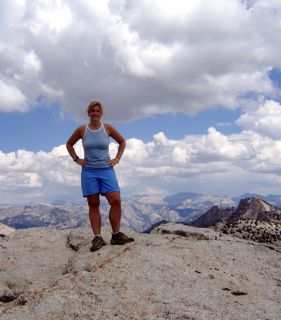For six years I’ve been one of the faithful lap swimmers at the El Portal pool, swimming a mile a day in the summer months, as it’s one of the few sports that doesn’t hurt my back. This year my fellow lapster and intrepid swimmer Mara Dale suggested that we put this training to good use and swim the length of Tenaya Lake at the end of summer.
 When she suggested the notion in June, it seemed like a great idea. As the end of August, approached, I began having some doubts. First, due to early exposure to Steven Spielberg and actually having been called out of the water on a Cape Cod beach due to a shark sighting, I have a rather large shark phobia. Despite the prevailing logic that sharks don’t inhabit Tenaya Lake, the whole “creatures ascending from the deep” fear is difficult to overcome.
When she suggested the notion in June, it seemed like a great idea. As the end of August, approached, I began having some doubts. First, due to early exposure to Steven Spielberg and actually having been called out of the water on a Cape Cod beach due to a shark sighting, I have a rather large shark phobia. Despite the prevailing logic that sharks don’t inhabit Tenaya Lake, the whole “creatures ascending from the deep” fear is difficult to overcome.
A concern rooted a bit more in reality was the water temperature. When we swim laps in El Portal, we enjoy bath water-like temperatures of 75-80 degrees. Somehow, at almost 9,000 feet, I didn’t think we’d be so lucky. Brevity has characterized my countless swims in high mountain lakes—a quick dip after a hot hike. Usually the numbness in one’s legs forces a quick retreat. To swim a mile is not a quick endeavor—it would probably take us at least 45 minutes, with my fastest time being 38 minutes in the pool.
Despite the risks of shark attacks and hypothermia, I remained determined. Steve Medley, YA’s president (and also a devoted lap swimmer) loaned me a wetsuit to combat the cold. Mara secured a wetsuit as well, and also arranged for Ed Billington, Yosemite NPS, to accompany us in his kayak for safety. Shad Stites, my partner, agreed to act as our wetsuit handler. Linda Eade, NPS research librarian, and her husband Mike Osbourne, retired NPS employee and fellow lapster, would act as our cheering squad. The weekend before the swim, I hiked to the top of Tenaya Peak, and took some photographs of the lake. Although I observed no large fish from my vantage point, the possibility remained of us knocking into one of the submerged trees in the lake.
The day of the swim afforded us the best in Sierra weather: a wonderful sunny and cloudless day. Mara and I hiked from the eastern to the western shore to get warmed up. With some assistance from Ed and Shad, we donned our wetsuits. Then after a slight goggles-malfunction, we we’re off!
 Ed paddled beside us keeping us on target and scouting for trees. We swam in unison, like synchronized swimmers, and glided through the dense blue water. As a swim, it was magical, and it allowed me to relax in a rhythm that one misses in a pool because of the regular turns. I had granite peaks surrounding me and a ghost forest below me (look for more on the ghostly trees of Tenaya Lake in an upcoming journal).
Ed paddled beside us keeping us on target and scouting for trees. We swam in unison, like synchronized swimmers, and glided through the dense blue water. As a swim, it was magical, and it allowed me to relax in a rhythm that one misses in a pool because of the regular turns. I had granite peaks surrounding me and a ghost forest below me (look for more on the ghostly trees of Tenaya Lake in an upcoming journal).
We finished in just under fifty minutes, hurried along by Mike on the shore yelling to us that we needed to hurry because he was hungry and wanted to get to the Mobil Station. Thanks to Ed’s able guidance, the swim went quite smoothly. Mara and I have now vowed to swim a new lake each year. Lake Eleanor or Saddlebag Lake are the possible candidates for 2006! And yes, we headed to the Whoa Nellie Deli and feasted on the delicious food. I even had the chocolate cake.














